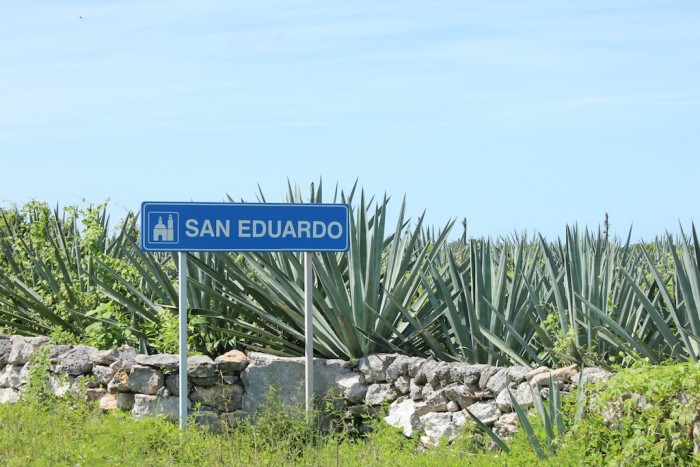
So our second stop of the day was to visit Hacienda San Eduardo near Telchac Pueblo in a town called Dzemul. Francisco’s father brought us all to the local hacienda so that we could explore the area. I am not sure if this location is open for tours, but he went and got the person from his house down the street and we all received a private tour of the facility. This is a working henequin plant so we got to see a lot of interesting things. Hacienda San Eduardo was built 100 years ago, with additions in the year 1943. Much of what we saw was the original construction.
There is a beautiful little church attached to the main building, a working factory, a drying section, a storage section and fields of agave which are grown to produce the henequin!
[tribulant_slideshow post_id=”5959″]



I thought that ropes were made of synthetic materials now and that making sisal ropes was a thing of the past!
They have now started making clothes using this fibre as well. There have always been some henequin plants operating to make many items but it appears as though they are trying to make a comeback. If the natural fibres work well in clothes, there may be a lot of work to do for the Yucatan people!
Deb, I live just 1 hr away from Hacienda San Eduardo, and I was surprise too in how much is this fiber use still, I found this article, hope is helpful to you to….Sisal fibre is derived from the leaves of the plant. It is usually obtained by machine decortications in which the leaf is crushed between rollers and then mechanically scraped. The fibre is then washed and dried by mechanical or natural means. The dried fibre represents only 4% of the total weight of the leaf. Once it is dried the fibre is mechanically double brushed. The lustrous strands, usually creamy white, average from 80 to 120 cm in length and 0.2 to 0.4 mm in diameter.
Sisal fibre is fairly coarse and inflexible. It is valued for cordage use because of its strength, durability, ability to stretch, affinity for certain dyestuffs, and resistance to deterioration in saltwater. Sisal is used by industry in three grades:
The lower grade fibre is processed by the paper industry because of its high content of cellulose and hemicelluloses.
The medium grade fibre is used in the cordage industry for making: ropes, baler and binders twine. Ropes and twines are widely employed for marine, agricultural, and general industrial use.
The higher-grade fibre after treatment is converted into yarns and used by the carpet industry.
The fibre is also used for non-woven matting, brushing and roving.
Brazil is the largest world producer of sisal fibre with 130,000 tons/year. Sisal is the only crop that resists the semi-arid climate and which is economically feasible to the poor northeast region of the country where around 800,000 people depend on it. Besides Brazil sisal is also produced in Mexico (45,000 tons/year); China (36,000 tons/year); Tanzania (24,000 tons/year); Kenya (25,000 tons/year) and Madagascar (15,000 tons/year).
Source: FAO.